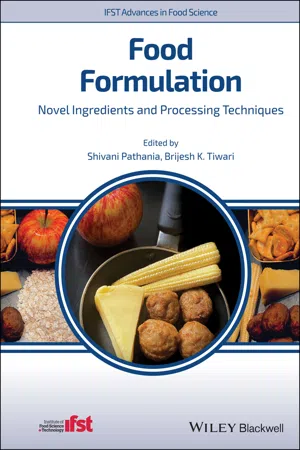
Food Formulation
Novel Ingredients and Processing Techniques
- English
- ePUB (mobile friendly)
- Available on iOS & Android
About This Book
Reviews innovative processing techniques and recent developments in food formulation, identification, and utilization of functional ingredients
Food Formulation: Novel Ingredients and Processing Techniques is a comprehensive and up-to-date account of novel food ingredients and new processing techniques used in advanced commercial food formulations. This unique volume will help students and industry professionals alike in understanding the current trends, emerging technologies, and their impact on the food formulation techniques. Contributions from leading academic and industrial experts provide readers with informed and relevant insights on using the latest technologies and production processes for new product development and reformulations.
The text first describes the basis of a food formulation, including smart protein and starch ingredients, healthy ingredients such as salt and sugar replacers, and interactions within the food components. Emphasizing operational principles, the book reviews state-of-the-art 3D printing technology, encapsulation and a range of emerging technologies including high pressure, pulsed electric field, ultrasound and supercritical fluid extraction. The final chapters discuss recent developments and trends in food formulation, from foods that target allergies and intolerance, to prebiotic and probiotic food formulation designed to improve gut health. A much-needed reference on novel sourcing of food ingredients, processing technologies, and application, this book:
- Explores new food ingredients as well as impact of processing on ingredient interactions Describes new techniques that improve the flavor and acceptability of functional food ingredients
- Reviews mathematical tools used for recipe formulation, process control and consumer studies
- Includes regulations and legislations around tailor-made food products
Food Formulation: Novel Ingredients and Processing Techniques is an invaluable resource for students, educators, researchers, food technologists, and professionals, engineers and scientists across the food industry.
Frequently asked questions
Information
1
Food Formulation and Product Development
Summary
1.1 Introduction
1.2 New Product Development
1.3 Challenges in Food Formulations

1.4 Relevance of the Book and Objectives
- Ingredients and their interactions (Chapters 2–5): The first section of the book consists of a number of chapters covering the basis of a food formulation, i.e. ingredients. Smart and functional ingredients from plant and animal sources; healthy ingredients such as replacements for salt, sugar, and phosphate, bioactives, and peptides; macronutrient and micronutrient ingredient interactions.
- Processing techniques (Chapters 6–9): This section outlines the application of emerging technologies in the processing of new food formulations. New techniques such as 3D printing for tailor‐made, demand‐driven production and products with geometric intricacy is covered (Chapter 6). The role of encapsulation techniques (Chapter 7), extrusion (Chapter 8), and combination techniques to improve the flavour and acceptability of functional food ingredients and recent developments in greener technologies including high pressure, microwave heating, ultrasound, supercritical fluid extraction, pulsed electric fields, ohmic heating, dielectric heating and other emerging technologies are discussed, with emphasis on the operational principles and inherent strengths and weaknesses of the technologies (Chapters 8 and 9) from a food formulation viewpoint.
- New trends in food formulation (Chapters 11–12): This section describes recent trends in the development of food for specific challenges for targeted populations, food targeting allergies and intolerances (gluten‐free and lactose‐free products), and prebiotic and probiotic food formulation for gut health.
Table of contents
- Cover
- Table of Contents
- Series Page
- Title Page
- Copyright Page
- List of Contributors
- Preface
- 1 Food Formulation and Product Development
- 2 Smart Functional Ingredients
- 3 Healthy Ingredients
- 4 Macromolecules Interactions in Food Formulations
- 5 Effect of Ingredient Interactions on Techno‐Functional Properties
- 6 3D Printing
- 7 Encapsulation Technologies Applied to Food Processing
- 8 Advances in Extrusion Technologies
- 9 Thermal Processing Technologies
- 10 Non‐thermal Processing Technologies: High Pressure Processing and Others
- 11 Formulation for Food Intolerance
- 12 Prebiotic and Probiotic Food Formulations
- 13 Mathematical Tools for Food Formulation
- 14 Regulatory and Legislative Framework for Novel Foods
- Index
- End User License Agreement